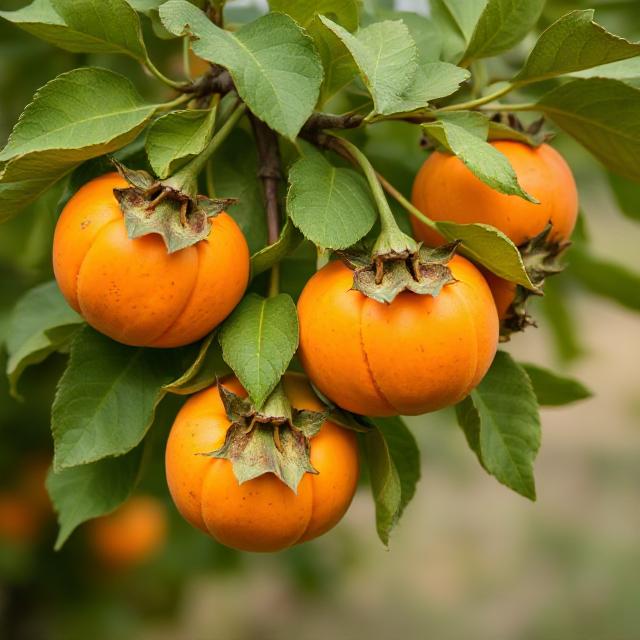Persimmon Fruit: Nutrition, Benefits, and How to Eat the Japanese Superfruit
🍁 Introduction: The Golden Jewel of Autumn — Persimmon Fruit
Imagine a fruit that looks like an orange tomato, tastes like honey with a hint of mango, and is packed with nutrients that strengthen your heart, eyes, and immunity. That’s Persimmon Fruit — a sweet, bright-orange fruit that has been cherished for centuries across Japan, China, and Korea.
Known as the “fruit of the gods”, Persimmon (Diospyros kaki) is not only delicious but also a nutritional powerhouse. It’s rich in fiber, antioxidants, and vitamins that promote overall wellness.
In recent years, this exotic fruit has gained popularity in India, especially among health-conscious consumers, owing to its benefits for diabetes control, pregnancy health, and skincare.
Let’s dive deep into everything you need to know about this golden-orange wonder — its origin, nutrition, benefits, and the right way to enjoy it.
🍊 1. What Is Persimmon Fruit?
The Persimmon Fruit is a soft, sweet, and slightly tangy fruit that belongs to the Ebenaceae family. The most common variety is Japanese Persimmon (Diospyros kaki), known for its rich color and honey-like flavor.
Quick Facts:
- Scientific Name: Diospyros kaki
- Common Names: Japanese Persimmon, Korean Persimmon, Kaki Fruit, Oriental Persimmon
- Native Regions: China and Japan (now cultivated worldwide, including India and the U.S.)
- Season: Autumn to Winter (October–February)
- Color: Deep orange to reddish-orange when ripe
The fruit has a smooth, glossy skin and a texture similar to a ripe tomato. Depending on the variety, it may be astringent (tangy when unripe) or non-astringent (sweet even when firm).
🌏 2. Persimmon Origin: Where Did It Come From?
Persimmon’s roots trace back to China, where it has been cultivated for over 2,000 years. The name Diospyros kaki translates to “food of the gods” in Greek, emphasizing its divine taste and nutritional value.
From China, it spread to Japan and Korea, becoming an essential part of East Asian culture and cuisine.
Today, Japan is one of the largest producers and consumers of persimmons. The fruit also grows well in India’s hilly regions — Himachal Pradesh, Uttarakhand, and parts of Jammu & Kashmir.
🌿 3. Persimmon Nutrition: What’s Inside the Golden Fruit?
Despite its sweetness, Persimmon is incredibly nutritious. It’s low in fat, rich in fiber, and packed with antioxidants that protect your body from diseases.
Nutritional Value (per 100g of Persimmon):
| Nutrient | Amount |
|---|---|
| Calories | 81 kcal |
| Carbohydrates | 21 g |
| Fiber | 3.6 g |
| Protein | 0.8 g |
| Fat | 0.2 g |
| Vitamin A | 81 µg (16% DV) |
| Vitamin C | 7.5 mg (9% DV) |
| Potassium | 161 mg |
| Manganese | 0.3 mg |
| Beta-Carotene | 253 µg |
Key Highlights:
- High in Vitamin A and beta-carotene → supports vision and skin health.
- Rich in antioxidants → combats oxidative stress and aging.
- Low in fat, high in fiber → promotes digestion and weight management.
💪 4. Benefits of Persimmon: Why You Should Add It to Your Diet
Persimmon is not just beautiful — it’s beneficial from head to toe. Let’s explore its science-backed health benefits.
a. Boosts Immunity
Thanks to its Vitamin C content, persimmon strengthens your immune defense against infections, flu, and common cold.
b. Promotes Heart Health
Persimmons are rich in flavonoids and potassium, which help lower bad cholesterol (LDL) and regulate blood pressure.
c. Supports Eye Health
The Vitamin A and lutein in persimmon improve night vision and protect against macular degeneration.
d. Aids Digestion
High dietary fiber helps regulate bowel movements and prevent constipation.
e. Anti-Aging & Skin Benefits
Antioxidants like beta-carotene and polyphenols protect the skin from wrinkles, pigmentation, and UV damage.
f. Weight Management
Low in calories and high in fiber, persimmons make for a filling, guilt-free snack.
g. May Help Manage Diabetes
Certain compounds in persimmon help reduce oxidative stress and improve insulin sensitivity (more on that below).
🤰 5. Persimmon in Pregnancy: Safe or Not?
Yes, persimmon is safe to eat during pregnancy when consumed in moderation. It provides vital nutrients like folate, iron, and calcium, which support fetal development and maternal health.
Benefits for Pregnant Women:
- Provides natural energy and reduces fatigue.
- High iron content prevents anemia.
- Fiber relieves pregnancy constipation.
- Vitamin C boosts immunity during gestation.
However, since persimmons are high in natural sugars, excessive intake can increase blood glucose levels. Pregnant women with gestational diabetes should consult their doctor before eating regularly.
🩸 6. Persimmon Good for Diabetes?
Yes, but with caution. Persimmon has a medium glycemic index (GI 50–70). Its fiber helps slow sugar absorption, but the fruit’s sweetness demands portion control.
Tips for Diabetics:
- Limit to ½ fruit per day.
- Choose ripe but firm persimmons (less sugar content).
- Pair with protein-rich snacks (like nuts) to stabilize glucose levels.
✅ Verdict: Persimmon can be part of a diabetic diet — in moderation and with medical advice.
🧠 7. Japanese Fruit Persimmon: Cultural & Culinary Significance
In Japan, persimmon (called Kaki) is a symbol of good fortune and longevity. During autumn, you’ll find persimmons hanging outside homes to dry — known as Hoshigaki — a traditional delicacy made from sun-dried persimmons.
Popular Japanese Uses:
- Hoshigaki (Dried Persimmons) – chewy, naturally sweet snack
- Kaki Salad – sliced persimmons with sesame dressing
- Persimmon Sake & Vinegar – fermented beverages
This cultural connection has made persimmon a beloved autumn fruit across East Asia.
🪴 8. Persimmon Fruit Plant: How It Grows
The persimmon plant is a deciduous tree that grows up to 10 meters tall. It thrives in temperate climates and produces fruits in late autumn.
Growing Conditions:
- Soil: Well-drained, loamy soil
- Temperature: 10°C–25°C
- Sunlight: Full sun for optimal sweetness
- Time to Fruit: 3–5 years after planting
In India, persimmon cultivation is expanding in Uttarakhand, Himachal Pradesh, and Meghalaya, owing to favorable weather conditions.
🍽️ 9. How to Eat Persimmon (Step-by-Step Guide)
The right way to eat a persimmon depends on its variety:
Two Main Types:
- Astringent Persimmon (e.g., Hachiya):
- Must be fully ripe before eating (jelly-like texture).
- Unripe ones taste bitter due to tannins.
- Best eaten by scooping the pulp with a spoon.
- Non-Astringent Persimmon (e.g., Fuyu):
- Can be eaten firm, like an apple.
- Slice and enjoy raw or add to salads.
Eating Tips:
- Wash thoroughly and remove the leafy cap.
- You can eat the peel if it’s smooth and clean.
- Add to yogurt, oatmeal, or smoothies for a flavorful boost.
- For desserts, bake or dry the slices for natural sweetness.
🥗 10. Best Time to Eat Persimmon
- Morning or Midday: For energy and easy digestion.
- Avoid eating at night, especially for diabetics, due to sugar content.
- Consume fresh fruit rather than processed versions for maximum nutrients.
💆♀️ 11. Persimmon for Skin & Hair
Persimmons are a beauty secret in many Asian skincare traditions.
Skin Benefits:
- Vitamin C boosts collagen and fights aging.
- Polyphenols help reduce acne and pigmentation.
- Natural enzymes gently exfoliate dead skin cells.
DIY Persimmon Face Mask:
Mix 2 tbsp persimmon pulp with 1 tsp honey and 1 tsp yogurt.
Apply for 15 minutes, then rinse with lukewarm water.
Result: Softer, glowing skin!
🌸 12. Possible Side Effects of Persimmon
While persimmon is healthy, overconsumption may cause:
- High blood sugar (in diabetics)
- Indigestion or bloating due to excess tannins
- Constipation if eaten unripe (high in tannic acid)
Tip: Eat ripe persimmons in moderation — one medium fruit per day is ideal.
📜 13. Fun Facts About Persimmon
- The word Persimmon comes from the Native American word “pessamin”, meaning “dry fruit.”
- Japan’s most famous variety, Hachiya Kaki, turns translucent when ripe — a sign it’s ready to eat.
- Dried persimmons are considered a natural candy in East Asia.
- In Korea, it’s called Gam, used to make sweet tea known as Sujeonggwa.
💬 14. Frequently Asked Questions (FAQ)
Q1. Can I eat persimmon daily?
Yes, but one fruit per day is sufficient to get its benefits without raising sugar levels.
Q2. Is persimmon a fruit or a berry?
Technically, it’s a berry, because it develops from a single flower with multiple seeds.
Q3. Is persimmon available in India?
Yes, especially in Himachal Pradesh, Kashmir, and Uttarakhand during winter months.
Q4. Is persimmon high in sugar?
Yes, persimmon has natural fructose. Diabetics should eat smaller portions.
Q5. Can persimmon cause allergies?
Rarely, but some people may experience mild itching or oral sensitivity. Always wash before eating.
🌞 15. Key Takeaways
| Feature | Details |
|---|---|
| Fruit Name | Persimmon (Diospyros kaki) |
| Origin | China & Japan |
| Taste | Sweet, honey-like |
| Nutrients | Vitamin A, C, Fiber, Antioxidants |
| Benefits | Heart health, digestion, skin glow, immunity |
| Best Time to Eat | Morning or noon |
| Caution | Moderation for diabetics and cold climates |
⚠️ Disclaimer
This article is for educational purposes only. The information provided should not replace medical advice or diagnosis.
If you have diabetes, pregnancy complications, or fruit allergies, consult your doctor or nutritionist before adding persimmon to your diet.












